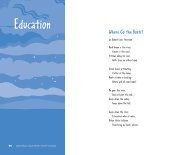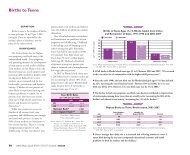2010 Rhode Island Kids Count Factbook
2010 Rhode Island Kids Count Factbook
2010 Rhode Island Kids Count Factbook
You also want an ePaper? Increase the reach of your titles
YUMPU automatically turns print PDFs into web optimized ePapers that Google loves.
College Preparation and Access<br />
DEFINITION<br />
College preparation and access is the<br />
percentage of <strong>Rhode</strong> <strong>Island</strong> high school<br />
seniors who graduate and immediately<br />
go on to college (i.e., enroll in a twoyear<br />
or four-year college anywhere in<br />
the country in the fall of the year they<br />
graduate from high school).<br />
SIGNIFICANCE<br />
Post-secondary education and/or<br />
training are increasingly critical in today’s<br />
job market. Three-quarters of the job<br />
growth in the U.S. requires a postsecondary<br />
degree or certificate of some<br />
kind. 1 While some students will choose<br />
to participate in service learning<br />
opportunities, technical training or<br />
obtain work experience before attending<br />
college, the rate of college entry<br />
immediately after high school can be an<br />
important measure of college access<br />
across states and communities. Just over<br />
half (55%) of <strong>Rhode</strong> <strong>Island</strong> seniors who<br />
graduated from high school in 2006<br />
went directly on to a two or four-year<br />
college the next fall, compared with 62%<br />
nationally. <strong>Rhode</strong> <strong>Island</strong> ranks 43rd in<br />
the U.S. and 6th in New England<br />
(where 1st is best). 2<br />
Many students who do enroll in<br />
college do not complete their degree.<br />
Nationally, three out of four young<br />
adults in the top income quartile earn a<br />
bachelor's degree, compared with one in<br />
ten young adults in the bottom income<br />
quartile. Black and Hispanic youth are<br />
less likely than White youth to enroll in<br />
and complete college. These differences<br />
by race and ethnicity often are the result<br />
of differences in family education and<br />
income levels and access to rigorous K-<br />
12 educational opportunities. 3,4 All<br />
students, but especially low-income and<br />
traditionally underserved students, need<br />
academic, financial and social supports<br />
to increase their college enrollment and<br />
college completion rates. 5,6<br />
Higher-income students are almost<br />
three times more likely to be<br />
academically prepared to succeed in<br />
college than their low-income peers. 7<br />
High schools that offer rigorous<br />
coursework, support student academic<br />
achievement, have high expectations for<br />
students, create college-going cultures,<br />
and increase access to college and<br />
financial aid counseling can improve<br />
the college enrollment and completion<br />
rates of their students. Another effective<br />
strategy for increasing college-going<br />
rates is to offer programs that provide<br />
high school students with the<br />
opportunity to enroll in college classes<br />
while still in high school. 8,9,10,11<br />
College access barriers include<br />
insufficient academic preparation,<br />
difficulty navigating the college<br />
application and financial aid process<br />
and the high cost of college relative to<br />
available financial aid. 12,13<br />
Factors that Influence Students’ Access to College<br />
Attending High Schools with “College-Going Cultures”<br />
◆ Guidance and information about the college application and enrollment process is<br />
critical throughout students’ high school experiences. Low-income and first-generation<br />
college students are significantly more likely to attend college when they attend high<br />
schools with strong college-going cultures, in which teachers encourage students to go<br />
to college, work to make sure that students are prepared and are involved in helping<br />
students with the college application process. 14<br />
Taking the SATs in Junior and/or Senior Year<br />
◆ While some colleges do not require the SATs for admission, students limit their choice<br />
of colleges when they do not take the SAT exams. In 2008, 74% of <strong>Rhode</strong> <strong>Island</strong> high<br />
school seniors reported planning to attend college, yet only 51% had taken the SATs. 15,16<br />
Accessing Rigorous Academic Coursework<br />
◆ Students who participate in upper-level honors and Advanced Placement (AP) courses are<br />
more likely to attend selective colleges and are better prepared to succeed in college than<br />
students who do not. 17 During the 2007-2008 school year, 15% of <strong>Rhode</strong> <strong>Island</strong> public<br />
school seniors took at least one AP exam, compared with the national rate of 25%. 18<br />
Completing the Application for Federal Financial Aid (FAFSA)<br />
◆ Applying for financial aid is a critical part of the college application process for<br />
low-income students. According to a 2008 study of students in Chicago public schools,<br />
students who completed the free application for federal student aid (FAFSA) were 50%<br />
more likely to enroll in a four-year college than their peers. 19<br />
Exploring Multiple Options for College<br />
◆ Applying to multiple colleges increases the likelihood that students will be accepted at<br />
two-year or four-year colleges that fit their needs, interests and skills and increases the<br />
likelihood that students will succeed in college. High-achieving urban and low-income<br />
students frequently do not apply to college at all or enroll in less selective colleges and<br />
universities even when they have the qualifications to be admitted at more selective<br />
schools. 20,21<br />
152 <strong>2010</strong> <strong>Rhode</strong> <strong>Island</strong> KIDS COUNT <strong>Factbook</strong> / Education






